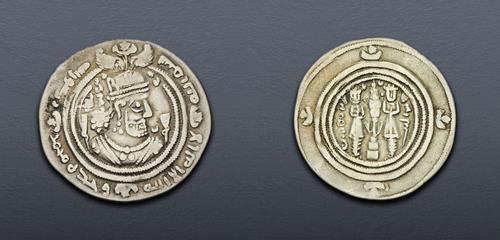
|
Pre-reform issues, Arab-Sasanian. temp 'Abd al-Malik b. Marwan. AH 65-86 / AD 685-705. AR Drachm (30mm, 3.33 g, 3h). AKWLA (Aqola, near al-Kufa) mint. Dated AH 72 (AD 691/2). VF.
CNG Islamic Auction 2
Lot: 6. Estimated: $ 15 000
Arab-Sasanian and other Pre-reform issues, Silver
Sold For $ 20 000. This amount does not include the buyer’s fee.
Go to Live
|
|
Pre-reform issues, Arab-Sasanian. temp 'Abd al-Malik b. Marwan. AH 65-86 / AD 685-705. AR Drachm (30mm, 3.33 g, 3h). AKWLA (Aqola, near al-Kufa) mint. Dated AH 72 (AD 691/2). Obverse: Sasanian royal bust to left, without name-legend before, crescent by chin, bismillah - la ilaha illa Allah - wahdahu Muhammad - rasul Allah in margin around / Reverse: Fire-altar with attendants, date to left, mint-signature to right. VF. Excessively rare and apparently unpublished.
This important transitional drachm provides further evidence for the evolution of the early Islamic silver coinage, as the old Sasanian-type drachms were gradually replaced by reformed dirhams durimg the 70s/690s. The primary centres for change were Damascus, the Umayyad capital, and the two mints of Basra and Aqola (near al-Kufa), which were under the control of the Caliph’s brother, Bishr b. Marwan. Damascus had never been under Sasanian control and so had no history of striking these drachms, but, coinage being the conservative medium it is, it was evidently decided that Damascus drachms should look similar to other Arab-Sasanian silver. At Aqola and Basra, the position was somewhat different; both mints had a history of striking normal Arab-Sasanian drachms bearing governors’ names. However, the present coin demonstrates that Damascus and Aqola faced a similar headache in the year AH 72: whose name, if any, should go in the field before the Sasanian royal bust.
At Damascus, it seems that the first solution to this was to put Muhammad rasul Allah in this position, but this was soon abandoned. Instead, the familiar Pahlawi name-legend of the long-dead Khusraw II reappears on Damascus dirhams dated AH 72, 73 and 74 (see lot 10), although the mint-name and date on the reverse of these coins is written in Arabic rather than Pahlawi. But Aqola and Basra took a different approach. On the reverse, the mint and date are rendered in Pahlawi, just as on previous Arab-Sasanian drachms. While all previous Arab-Sasanian drachms had named someone as a secular authority, whether an Arab governor or a long-dead Sasanian monarch, the obverse of the present coin anticipates the post-reform Umayyad silver coinage in being completely anonymous. The four quadrants of the obverse margin carry the Profession of Faith, proudly and overtly identifying the coin as an Islamic issue, but the space before the royal bust is left blank. However, as at Damascus, it seems that this design was soon abandoned and the name of Bishr b. Marwan, once again written in Pahlawi, reappears on the ‘Orans’ drachms struck at Aqola in the following year (see lot 7). Might it have been felt that, in the absence of any other name on the coin, placing Muhammad rasul Allah near the Sasanian bust could be interpreted as associating the royal portrait with the Prophet himself?
The final winners of all CNG Islamic Auction 2 lots will be determined during the live sale that will be held on 27 October 2022.
Winning bids are subject to a 22.5% buyer's fee for bids placed on this website and 25% for all others.
We recognize that our users may have various Internet Browsers and Operating Systems. We like our visitors to have the best possible experience when using our bidding platform. However, we do recognize that it is impossible to develop applications that work identically, efficiently and effectively on all web browsers The CNG bidding platform supports the latest stable major version and stable previous version of Chrome and Firefox.
|
